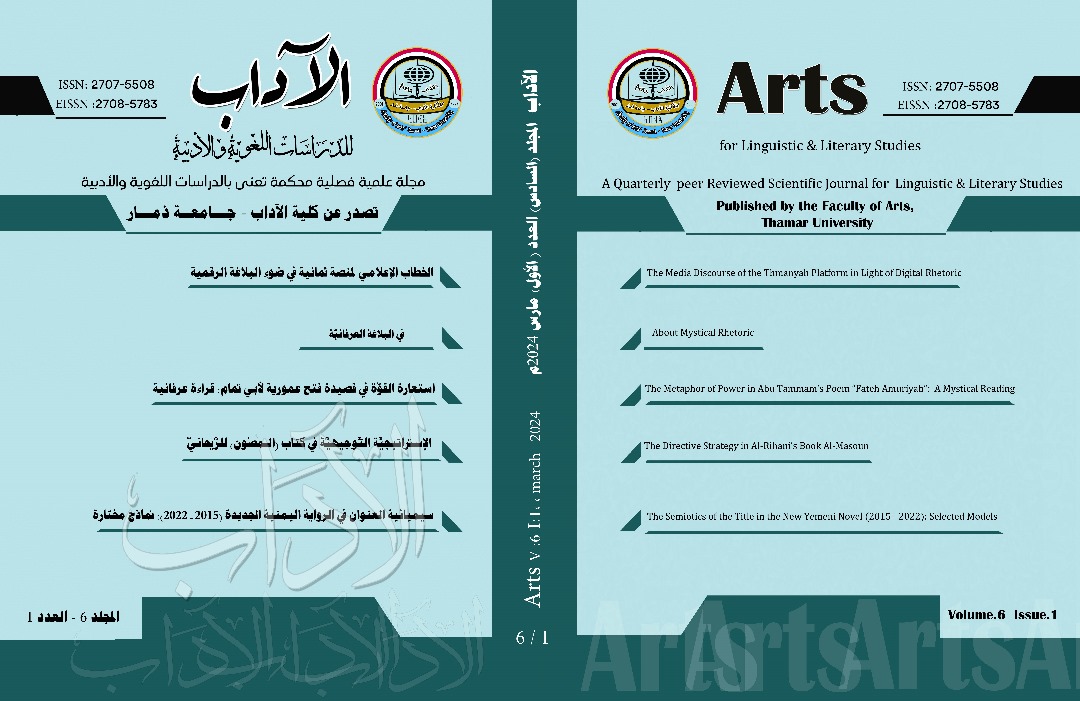Analytical Imagination: An Exploration of Imagination in Ancient and Contemporary Writings
DOI:
https://doi.org/10.53286/arts.v6i1.1800Keywords:
Imagination, Analytical Imagination, Literary Creation, Literary InterpretationAbstract
The paper examines the concept of imagination from a creative perspective, focusing on a central question concerning the author's level of control over the imaginative nature of his work. Using a comparative textual analysis approach, the discussion looks at specific writings to find similarities and differences in order to clarify the complex relationship between literature and imagination. The paper is organized into an introduction, two analytical sub-sections titled "Imagination" and "Analytical Imagination," and a conclusion. The introduction included a brief literature review as well as the methodological approach, which guided the main research questions about the relationships between literature and imagination and how those connections affect the interpretation process. It concludes with a reflection on the evolution of the Romantic notion of the poetic imagination in modern times (as envisioned by Pound and Beckett) and establishes a link between Aristotle's Mimesis and the concept of analytical imagination.
Downloads
References
Aristotle. (1930). De anima (J. A. Smith, Trans). Psychclassics. https://psychclassics.yorku.ca/Aristotle/De-anima/index.htm (Original work published ca. 350 B.C.E)
Aristotle. (1996). Poetics (Malcolm Heath Trans.). Penguin Books. (Original work published ca. 330 B.C.E)
Babuts, N. (2011). Mimesis in a Cognitive Perspective: Mallarme, Flaubert, and Eminescu. Routledge.
Bachelard, G. (2000). The Psychoanalysis of Fire. Beacon.
Bachelard, G. (2014). The Poetics of Space. Penguin Books.
Beckett, S. (1978). Proust. Grove Press.
Beckett, S. (1983). An imaginative work!. In R. Cohn (Ed.) Disjecta: Miscellaneous Writings and a Dramatic Fragment (pp. 89–90). John Calder.
Coleridge, S. T, (1817). “Biographia Literaria.” Gutenberg. https://www.gutenberg.org/files/6081/6081-h/6081-h.htm#link2HCH0013
Hacker, p (2010). Human Nature: The Categorial Framework. Wiley-Blackwell.
Ipsen, G. (2009) The value of literature: the disparity between 'Practical Criticism' and 'Modern Literary Theory' with a case study of Thomas Hardy [Doctoral thesis, University College London]. University of London Research Repository. https://discovery.ucl.ac.uk/id/eprint/17277/
Kast, V. (2014). Complexes and imagination. The Journal of Analytical Psychology, 59(5), 680–694. https://doi.org/10.1111/1468-5922.12113
Kemal, S. (1988). Medieval Arabic Poetics: Poetic Syllogism and Community in Avicenna’s Commentary on Aristotle’s Poetics. Philosophy Research Archives, 14(1), 20–122. https://doi.org/10.5840/PRA1988/198914SUPPLEMENT35
Kiesselbach, D. (2012). Salt Pier. University of Pittsburgh Press.
Kim, J. (2006). Piagetian and Vygotskian Perspectives on Creativity. The International Journal of Creativity and Problem Solving, 16(1), 25–38. G704-000413.2006.16.1.008
Knowlson, J. (1996). Damned to Fame: The Life of Samuel Beckett. Bloomsbury.
Koopman, E. & Hakemulder, F. (2015). Effects of Literature on Empathy and Self-Reflection: A Theoretical-Empirical Framework. Journal of Literary Theory, 9(1), 79–111. https://doi.org/10.1515/jlt-2015-0005
Marshall, D. G. (1982). Ideas and History: The Case of “Imagination.” Boundary 2, 10(3), 343–359. https://doi.org/10.2307/302801
Mooij, J. (1993). Fictional Realities: The uses of literary imagination. John Benjamin Publishing Company.
Oatley, K. (1995). A taxonomy of the emotions of literary response and a theory of identification in fictional narrative. Poetics, 23(1-2), 53–74. https://doi.org/10.1016/0304-422X(94)P4296-S.
O’Brien, J. (1993). Reasoning with the Senses: The Humanist Imagination. South Central Review, 10(2), 3-19. https://doi.org/10.2307/3189996
Pagels, E. (1988). Adam, Eve, and the Serpent. Random House.
Pardales, M. (2002). "So, How Did You Arrive at that Decision?" Connecting Moral Imagination and Moral Judgement. Journal of Moral Education, 31(4), 423–437. https://doi.org/10.1080/0305724022000029653.
Reinert, O. (2010). Ibsen and Mimesis. Scandinavian Studies, 82(2), 213–230. https://doi.org/10.2307/40908164.
Pickvance, C. (2001). Four varieties of comparative analysis. Journal of Housing and the Built Environment, 16(1), 7–28. https://doi.org/10.1023/A:1011533211521.
Pound, E. (1951). ABC of Reading. Faber and Faber.
Riffaterre, M. (1984). Intertextual Representation: On Mimesis as Interpretive Discourse. Critical Inquiry, 11(1), 141–162. https://doi.org/10.1086/448279
Rundell, J. (2001). Imaginary Turns in Critical Theory: Imagining Subjects in Tension. Critical Horizons, 2(1), 61–92. https://doi.org/10.1163/156851601750170007.
Schaverien, J. (2007). Countertransference as active imagination: imaginative experiences of the analyst. The Journal of Analytical Psychology, 52(4), 413–31. https://doi.org/10.1111/J.1468-5922.2007.00674.X.
Smith, A. (1976). The Theory of Moral Sentiments ( D.D. Raphael and A.L. Macfie Eds.). Indianapolis: Liberty Classics.
Steadman, J. M. (1998). Image-Making in the Verbal and Visual Arts: A Renaissance Obsession. Huntington Library Quarterly, 61(1), 53–80. https://doi.org/10.2307/3817622
St. Armand, B. L. (1975). A Superior Abstraction: Todorov on the Fantastic [Review of The Fantastic: A Structural Approach to a Literary Genre, by T. Todorov & R. Howard]. NOVEL: A Forum on Fiction, 8(3), 260–267. https://doi.org/10.2307/1345108
Wordsworth, W. (1800). “Lyrical Ballads, with Other Poems, 1800, Volume 1.” Gutenberg. https://www.gutenberg.org/cache/epub/8905/pg8905.html.
Downloads
Published
How to Cite
Issue
Section
License

This work is licensed under a Creative Commons Attribution 4.0 International License.
Copyright and Licensing
copyright is retained by the authors. Articles are licensed under an open access Creative Commons CC BY 4.0 license, meaning that anyone may download and read the paper for free. In addition, the article may be reused and quoted provided that the original published version is cited. These conditions allow for maximum use and exposure of the work.


























